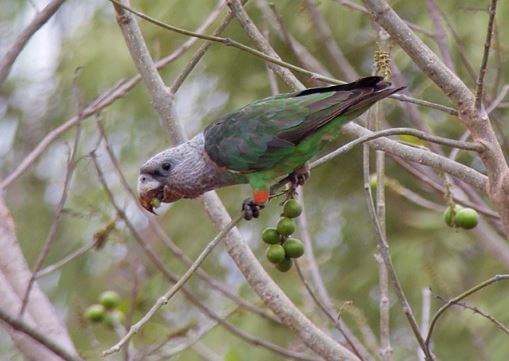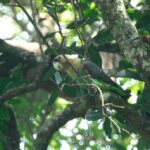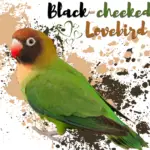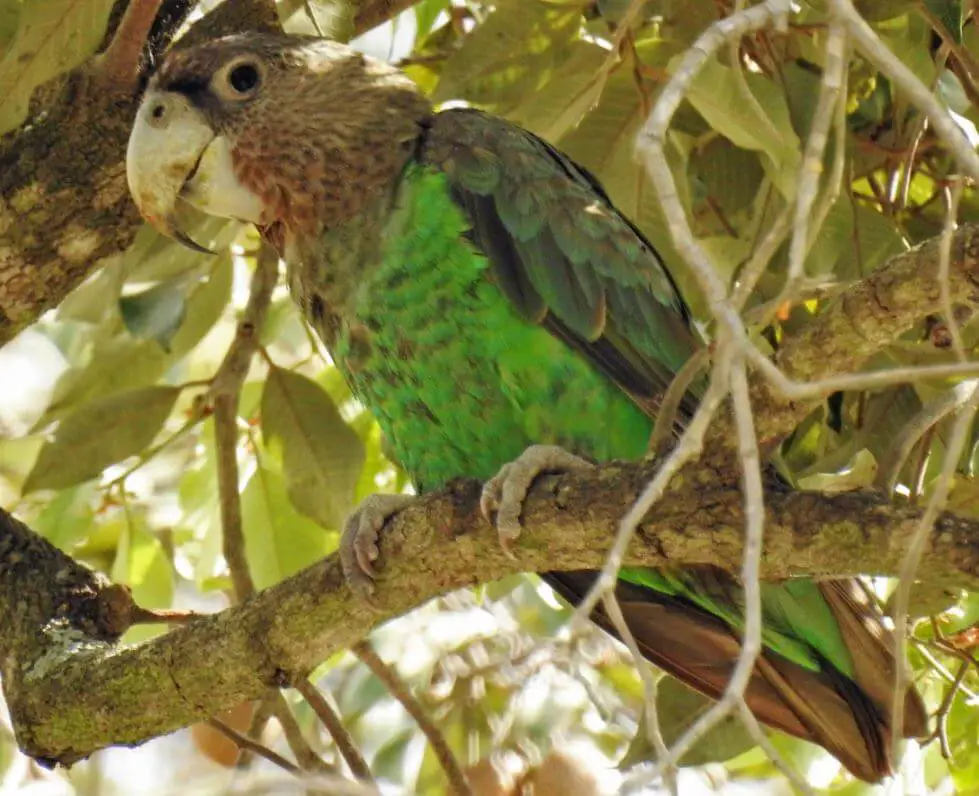
Identification
Brown necked Parrot (grey-headed) 30–36 cm; 280–401 g (suahelicus). A stocky parrot with a relatively large head and bill; gray to brown-gray head, females with red forehead (sometimes tinged reddish in the face);
upper parts (mantle, wing coverts, and secondaries) grayish-green to green; breast and belly green or greenwashed bluish.
Similar Species
Poicephalus fuscicollis differs from formerly conspecific P. robustus by its paler gray head and neck (vs. pale green in robustus);
grayer markings on the mantle, wing coverts, and flight feathers (vs. blacker and more extensive); generally more extensive red on the forehead of the female (sometimes none in female P. robustus);
generally more obvious pale fringes to flight feathers; slightly larger size (wing and tail), but distinctly larger bill; lower-frequency single notes and different note shapes.
Systematics History
Previously considered conspecific with P. robustus. Two subspecies are currently recognized.
Subspecies
Brown necked Parrot (Brown necked)Poicephalus fuscicollis fuscicollis Scientific name definitions
Systematics History
P. f. fuscicollis (Kuhl, 1820). [Type locality = The Gambia]; no specific type locality recorded.
Distribution
Patchily from the Gambia to EC Nigeria, lower R Congo, and N Angola (Cabinda).
Identification
Subspecies fuscicollis” data-visible=” false”>inlinemedia is smaller than suahelicus, and browner in the head and neck.
Brown necked Parrot (Gray headed)Poicephalus fuscicollis suahelicus Scientific name definitions
Systematics History
P. f. suahelicus Reichenow, 1898
Distribution
SC Angola and S DRCongo to SW Uganda and EC Tanzania (Nguru Mts), S to N Botswana and extreme NE South Africa (Limpopo).
Identification
Subspecies suahelicus larger than fuscicollis, with the heavier and more pointed bill, and grayer head and neck; green (tinged bluish) on mantle and underparts.
Distribution
Patchily distributed in West Africa from the Gambia to EC Nigeria, lower R Congo, and N Angola (Cabinda); also SC Angola and S DRCongo to SW Uganda and EC Tanzania (Nguru Mts), S to N Botswana and extreme NE South Africa (Limpopo).
Habitat
Subspecies suahelicus uses many types of woodland, chiefly well-developed formations such as riparian forest, intervening mopane and baobab woodland, undisturbed Baikiaea, and open or dense tall Brachystegia, with lowland or mid-altitude evergreen forest used for roosting but not feeding;
in Tanzania, ranges mostly only up to 300 m, 925 m in Ngurus; in Angola, no higher than 1,500 m, but reaching 2,300 m in Malawi; up to 2,200–4,000 m in the Democratic Republic of the Congo and to 2,000–3,600 m in Rwanda.
However, in southern Africa, the highest altitudes probably only visited post-breeding (November–February in Zambia). Seasonal differences in habitat use were reported in many regions, including northeastern South Africa. Reported to at least 2,300 m in Uganda.
The nominate race uses mature wooded savanna; in Ivory Coast, mainly in Borassus Ethiopia palm woodland in the forest-savanna mosaic;
in The Gambia, it frequents Rhizophora mangroves, and these are probably the main habitat of this subspecies; although, in Ghana, it frequents rich Daniella woodland and dry Sudanian forest types, and visits semi-evergreen rainforests.
Movement
Some populations or parts of populations resident, with others wandering extensively during dry seasons in search of food; e.g. in Malawi.
SOURCE: Discover PARROTS
Fruiting of Syzygium and Uapaca appears to cause a regular migration by part of Zambezi Valley population to the central plateau of Zimbabwe (Trelawney district), Brown-necked Parrot arriving in August, leaving by December, although in Matobo National Park the period of occupancy is May–October.
Similarly, a regular post-breeding visitor to the submontane forest, Malawi in November–February. Considered probably casual visitor rather than true African migrant in Nigeria, owing to an extended range of months recorded.
Subject to local movements in some years in the northern savannas of Ghana.
Diet and Foraging
Brown necked Parrot Seeds, nuts, berries, and nectar. In Zimbabwe, a frequent food source is the nut of mobile plum (Parinari curatellifolia), widespread in wetter areas and with an extended fruiting period,

July–November, with Montes glaber seeds in the dry season, also Erythrina (seeds and nectar), Uapaca, Pseudolachnostylis maprouneifolia, Syzygium cordatum, S. guineense,
Lannea discolor, Celtis Africana, Ricinodendron rautanenii, and Diospyros mespiliformis, with a heavy dependence on Ziziphus abyssinica berries, August–October.
In Malawi, seeds of Parinari excelsa are often taken, but also takes seeds of Adansonia digitata, Aningeria Adolf-friedericii, and Gmelina Arborea;
whereas, in Zambia, feeds on medium-sized fruits such as Parinari curatellifolia and P. excels, Podocarpus seeds, and young pods of Acacia polyacantha and Erythrina abyssinica. Podocarpus fruits are also taken in Rwanda.
In Northern Province, South Africa, recorded feeding on the fruit of 6 tree species during nonbreeding season and eight species when breeding, as well as the bark of 3 additional species at the latter season;
species included Gmelina Arborea (non-native), Sclerocarya birrea, Parinari curatellifolia, and Melia azedarach (non-native). Adansonia fruits are eaten in Angola.
In West Africa, the diet is less well known, but Ghana often consumes seeds of Daniella Oliveri in the northern savanna zone, but also takes seeds of Afzelia Africana, Ceiba pentandra, and Celtis mildbraedii. Drinks regularly at certain places in the early morning.
Sounds and Vocal Behavior
The commonest call of race suahelicus Brown necked Parrot is a distinctive short somewhat dissonant screech, “kheeh”, but also utters a variety of similar very short piercing notes, even in flight.
Overall, the calls of suahelicus are mainly short and rather flat-pitched with (on sonograms) clearly recognizable frequency bands and mostly within a frequency range of 100–500 Hz; this appears to be consistent with its possession of a “resonating nasal kraa”.
Breeding
Recorded most months of the year in southern Africa, with the chief period apparently March–April in Malawi; March–June, and October–November in Zimbabwe; April–June in Zambia; and April–August in northeastern South Africa and southeastern Zimbabwe.
Recorded in July in the Democratic Republic of the Congo; April–July in Tanzania; and February–April in the Gambia.
SOURCE: PippyPets
Brown necked Parrot Nest in a natural hole in the trunk of Brachystegia radii, Acacia glaucescens, Hyphaena ventricosa, Albizia tanganyicensis, Adansonia spiciform, or A. digitata, 5–12 m above ground, and in mangroves in the Gambia; chamber 50–75 cm deep; holes sometimes used previously by other birds (e.g., rollers).
Clutch 2–4 white eggs, size 30.4–36.8 mm × 26–30.2 mm (suahelicus); incubation 24–28 days, by Brown necked Parrot female alone; nestling period 8–11 weeks, young tended by both adults. Monogamous.
Conservation Status
Not globally threatened (Least Concern). CITES II. Populations of nominating probably impacted by capture for the pet trade; e.g., between 1975 and 2011, more than 9,000 wild-caught individuals were exported,
of which Guinea exported more than 50%, and between 1975 and 2011, more than 7,000 wild-caught suahelicus were exported with the majority (> 75%) coming from Tanzania before 2000 when trade was banned.
The threat of legal trade may have declined as reported exports are now low, but local trade may threaten some populations (e.g., in Zambia).
Habitat destruction, especially the loss of mature trees with nest cavities, threatens suahelicus in parts of southern and eastern Africa.
Poaching activity is considered the primary threat to populations outside protected areas, particularly as nest cavities are destroyed in process of removing chicks from nests, rendering the sites impossible to use in future years.
Common in Middle Zambezi and in the Ulugurus, Tanzania; locally common in Zambia, but sparse in northern Botswana, and uncommon and very local in Angola. Stable and widespread in Zambia, but restricted to small patches of fragmented woodland in Burundi.
Some evidence of a decline in Malawi. In South Africa, confined to the northern part of Kruger National Park, with seasonal incursions further southwest in Limpopo province.
Generally scarce or rare throughout West Africa except for Ghana, were fairly common, although unquestionably declining due to charcoal production; scarce and local in the Gambia; just 3 records in Liberia; rare and local, probably only casual in Nigeria,
although there are several recent records (e.g., Jos Plateau) and species are considered threatened by commercial logging, wood harvesting and land conversion for agriculture;
only 1 record from Sierra Leone, in November 1938; and in Togo, only a doubtful record in the 19th century and a recently confirmed observation. Records from Mali were rejected.
In western Uganda, known as Bwindi Impenetrable Forest and Virunga Volcanoes (were discovered in the 1980s), an old record from Kinkizi in July 1940, with recent reports from Lake Mburo National Park, Kibale National Park, and Budongo Forest Reserve.
Large numbers reported being trapped using bird lime for the cagebird trade. Annual movement out of Zambezi Valley to the central plateau, Zimbabwe, reflects food shortages in the former, so progressive destruction of indigenous woodland in the latter area may render the species much more vulnerable.





















